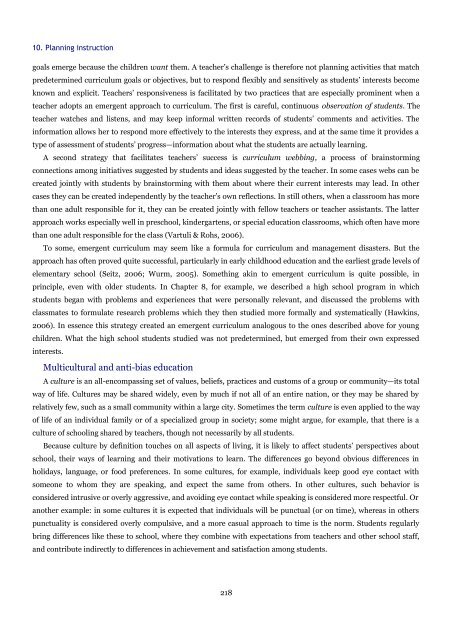Educational Psychology Third Edition Kelvin Seifert and Rosemary ...
Educational Psychology Third Edition Kelvin Seifert and Rosemary ...
Educational Psychology Third Edition Kelvin Seifert and Rosemary ...
You also want an ePaper? Increase the reach of your titles
YUMPU automatically turns print PDFs into web optimized ePapers that Google loves.
10. Planning instruction<br />
goals emerge because the children want them. A teacher’s challenge is therefore not planning activities that match<br />
predetermined curriculum goals or objectives, but to respond flexibly <strong>and</strong> sensitively as students’ interests become<br />
known <strong>and</strong> explicit. Teachers’ responsiveness is facilitated by two practices that are especially prominent when a<br />
teacher adopts an emergent approach to curriculum. The first is careful, continuous observation of students. The<br />
teacher watches <strong>and</strong> listens, <strong>and</strong> may keep informal written records of students’ comments <strong>and</strong> activities. The<br />
information allows her to respond more effectively to the interests they express, <strong>and</strong> at the same time it provides a<br />
type of assessment of students’ progress—information about what the students are actually learning.<br />
A second strategy that facilitates teachers’ success is curriculum webbing, a process of brainstorming<br />
connections among initiatives suggested by students <strong>and</strong> ideas suggested by the teacher. In some cases webs can be<br />
created jointly with students by brainstorming with them about where their current interests may lead. In other<br />
cases they can be created independently by the teacher’s own reflections. In still others, when a classroom has more<br />
than one adult responsible for it, they can be created jointly with fellow teachers or teacher assistants. The latter<br />
approach works especially well in preschool, kindergartens, or special education classrooms, which often have more<br />
than one adult responsible for the class (Vartuli & Rohs, 2006).<br />
To some, emergent curriculum may seem like a formula for curriculum <strong>and</strong> management disasters. But the<br />
approach has often proved quite successful, particularly in early childhood education <strong>and</strong> the earliest grade levels of<br />
elementary school (Seitz, 2006; Wurm, 2005). Something akin to emergent curriculum is quite possible, in<br />
principle, even with older students. In Chapter 8, for example, we described a high school program in which<br />
students began with problems <strong>and</strong> experiences that were personally relevant, <strong>and</strong> discussed the problems with<br />
classmates to formulate research problems which they then studied more formally <strong>and</strong> systematically (Hawkins,<br />
2006). In essence this strategy created an emergent curriculum analogous to the ones described above for young<br />
children. What the high school students studied was not predetermined, but emerged from their own expressed<br />
interests.<br />
Multicultural <strong>and</strong> anti-bias education<br />
A culture is an all-encompassing set of values, beliefs, practices <strong>and</strong> customs of a group or community—its total<br />
way of life. Cultures may be shared widely, even by much if not all of an entire nation, or they may be shared by<br />
relatively few, such as a small community within a large city. Sometimes the term culture is even applied to the way<br />
of life of an individual family or of a specialized group in society; some might argue, for example, that there is a<br />
culture of schooling shared by teachers, though not necessarily by all students.<br />
Because culture by definition touches on all aspects of living, it is likely to affect students’ perspectives about<br />
school, their ways of learning <strong>and</strong> their motivations to learn. The differences go beyond obvious differences in<br />
holidays, language, or food preferences. In some cultures, for example, individuals keep good eye contact with<br />
someone to whom they are speaking, <strong>and</strong> expect the same from others. In other cultures, such behavior is<br />
considered intrusive or overly aggressive, <strong>and</strong> avoiding eye contact while speaking is considered more respectful. Or<br />
another example: in some cultures it is expected that individuals will be punctual (or on time), whereas in others<br />
punctuality is considered overly compulsive, <strong>and</strong> a more casual approach to time is the norm. Students regularly<br />
bring differences like these to school, where they combine with expectations from teachers <strong>and</strong> other school staff,<br />
<strong>and</strong> contribute indirectly to differences in achievement <strong>and</strong> satisfaction among students.<br />
218


